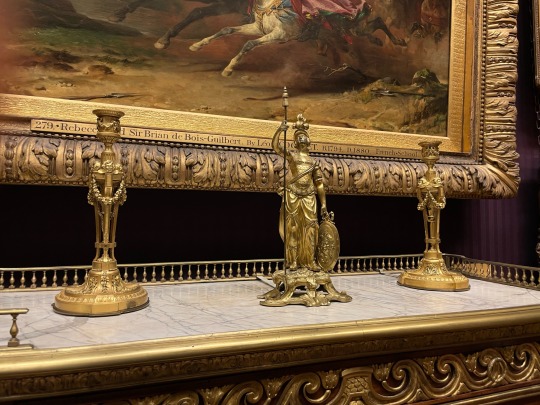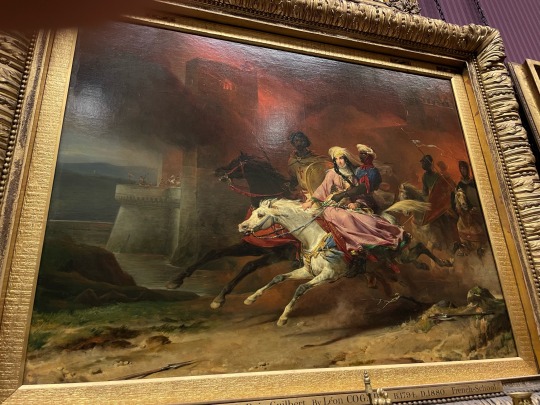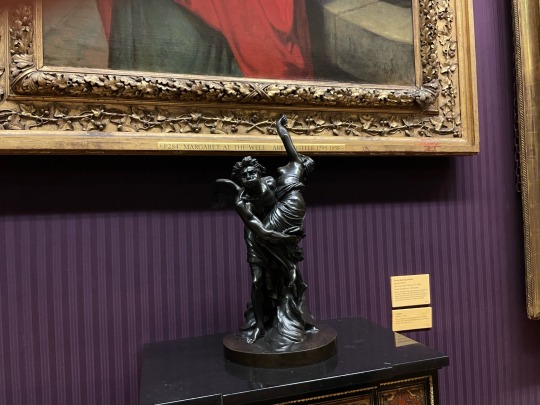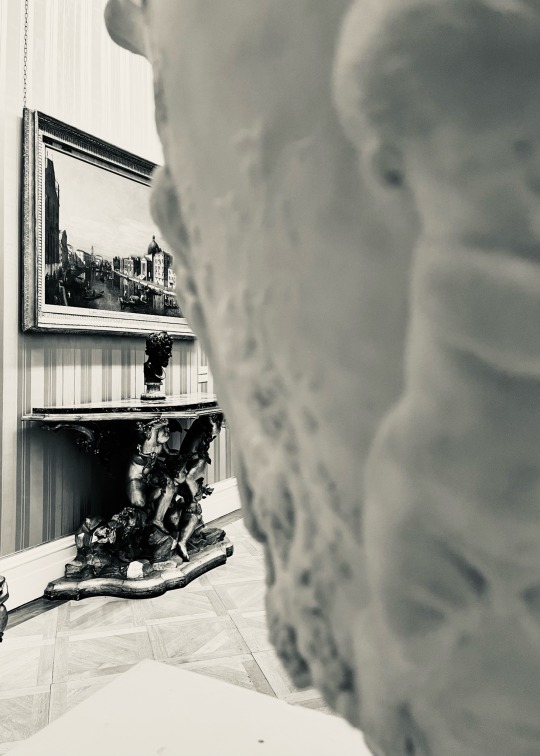#wallace collection
Explore tagged Tumblr posts
Text

Pendant Germany, late 16th century Pearls, gold, enamel H 5.2 x W 3.4 x D 1.5 cm “This particularly delightful pendant depicts a #rabbit or #hare, the flecked white-enamel points suggesting the animal’s fur.” The Wallace Collection W89
“One of the hallmarks of the Renaissance curiosity cabinet ('Kunstkammer') was the juxtaposition of marvels from the natural world with showpieces of human ingenuity. This duality can be seen in the small sculptures or items of jewellery created from large misshapen ‘baroque’ pearls, which became especially popular at princely courts from the late 16th century.”
#animals in art#european art#German art#jewelry#pendant#gold#pearl#rabbit#hare#Renaissance art#Wallace Collection
87 notes
·
View notes
Text
Steel Brocade: Puffed & Slashed Costume Armor
Surviving to this day in the collections of the world’s most illustrious museums are a group of three armors. These armors have much in common, but most striking is the attempts made by their armorers to render in steel a convincing portrayal of the puffed and slashed clothing fashionable to the early 16th century.
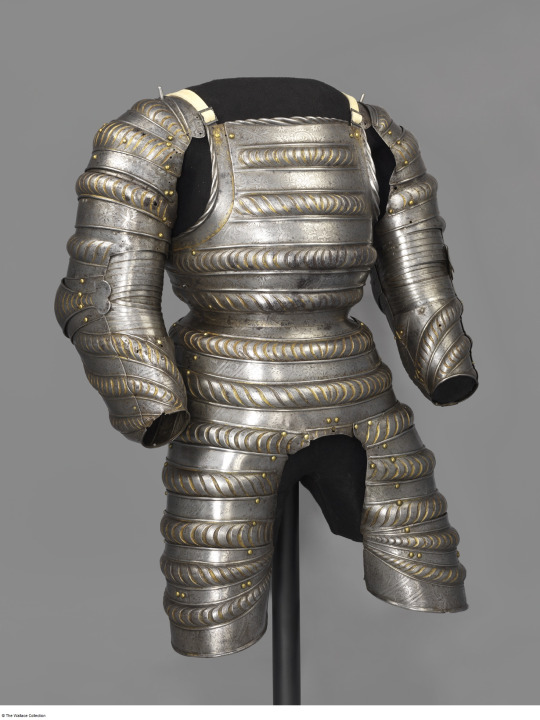

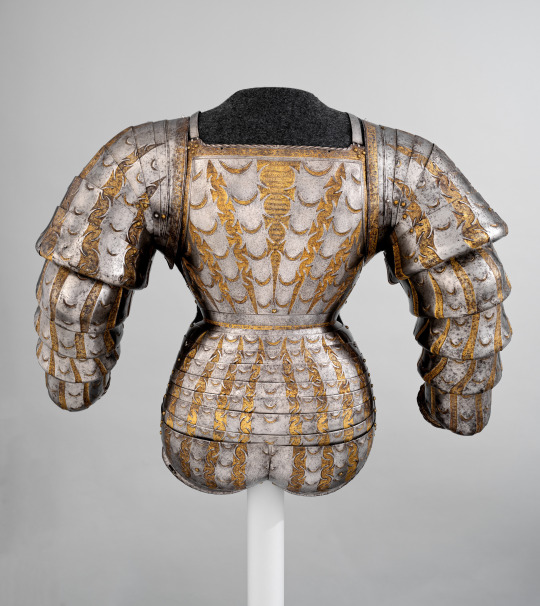
Though this fashion is synonymous with the landsknecht mercenaries who may have been responsible for popularizing it, the puffed and slashed style was enjoyed by members at all levels of society.
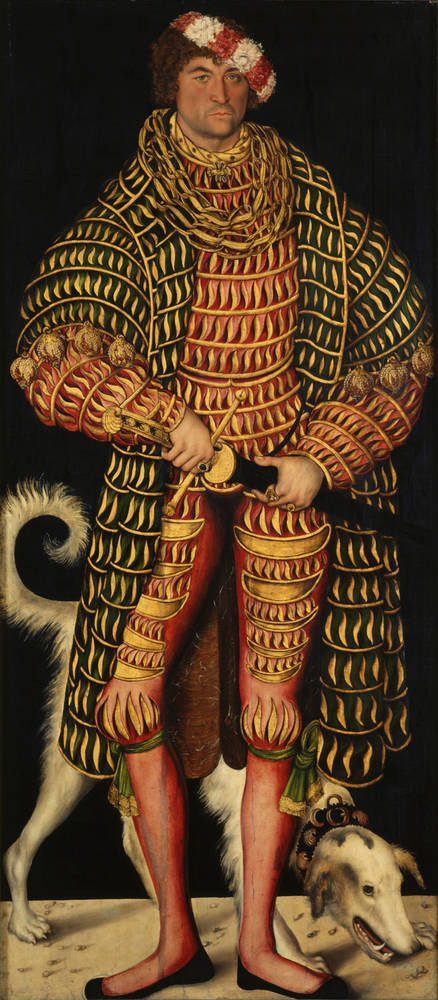
Portrait of Duke Henry of Saxony by Lucas Cranach the Elder, 1514, Staatliche Kunstsammlungen, Dresden.
The earliest of these three armors is housed at the Wallace Collection. Consisting only of a cuirass and arms, this armor is, at first glance, rather underwhelming when compared with the other armors in this group. Though the embossed bands styled with etched slashes embellished with gold provide the impression of a puffed and slashed doublet, the execution is all rather stiff, and lacks the impressive volume and fullness exemplified by the other armors.

It is for this reason that this armor, previously considered contemporary to the KHM and Metropolitan examples, has received relatively little attention. However, recent scholarship by Dr. Tobias Capwell suggests that this work is not, indeed, contemporary to the other examples, and is rather about ten years older, dating to ca. 1515. Dr. Capwell also considers this piece to be the work of Konrad Seusenhofer, a favored armorer of the Emperor Maximilian I.
Seen through this lens, not as a poorly executed contemporary of greater armors, but as a less developed ancestor to them, this armor takes on new life. It speaks to innovation and experimentation; an early attempt at a technique which would later be perfected.
The second in this line is the garniture of Wilhelm von Rogendorf, housed at the Kunsthistorisches Museum in Vienna.

This armor is unique for its condition, which is remarkably good. Not only does this armor retain more of its pieces than the other two, it is also accompanied by a number of “pieces of exchange,” elements which could be swapped out so the armor could be worn in the field.
Finished in 1523, as attested to by the date etched on the right shoulder strap, this armor was made for the Count Wilhelm von Rogendorf by Kolman Helmschmid and etched by Daniel Hopfer.

Wilhelm von Rogendorf himself was heir to a new, up-and-coming German noble family.

A medal showing Wilhelm von Rogendorf as a Knight of the Order of Calavatra, dated 1536, Kunsthistorisches Museum, Vienna.
Born in 1481 the second son of Kaspar von Rogendorf, Wilhelm became heir to his family’s estates when his elder brother Sigmund died in 1507, by which time Wilhelm was already a courtier at the Habsburg court. He entered into the service of King Charles I of Spain (later Emperor Charles V) no later than 1517 and was appointed Governor of Friesland. In 1522, Wilhelm accompanied Charles to Spain where he commanded a regiment of 4,000 landsknechts and was again placed in charge of a restless border territory. In 1524, he successfully captured the Fortress of Fuenterrabía from the French, which won him great praise from the Emperor. Shortly thereafter, Wilhelm was named Captain of the Imperial Bodyguard and given the governorships of Catalonia, the Cerdagne, and the Roussillon. Additionally, he was appointed to the Spanish chivalric Order of Calavatra. Wilhelm would retire from court in 1539, but would be recalled in 1541 to command Imperial troops against the Ottomans in Hungary. He would be killed later that same year at the siege of Buda by a stray cannonball.
Though Wilhelm’s armor is now displayed in its parade configuration, the surviving pieces of exchange attest to the fact that it was also an armor for combat. The cuirass is equipped with the long tassets common to the early 16th century. A pair of holes can be observed at the top of the last lame.

These holes correspond to holes at the top of the half-cuisses which accompany this armor, showing that these cuisses would be pointed to the tassets rather than worn separately.

In the rear, the cuirass is accompanied by a rump-defense, also known as a hoguine. Small turning pins near the waist allow this to be removed for combat.
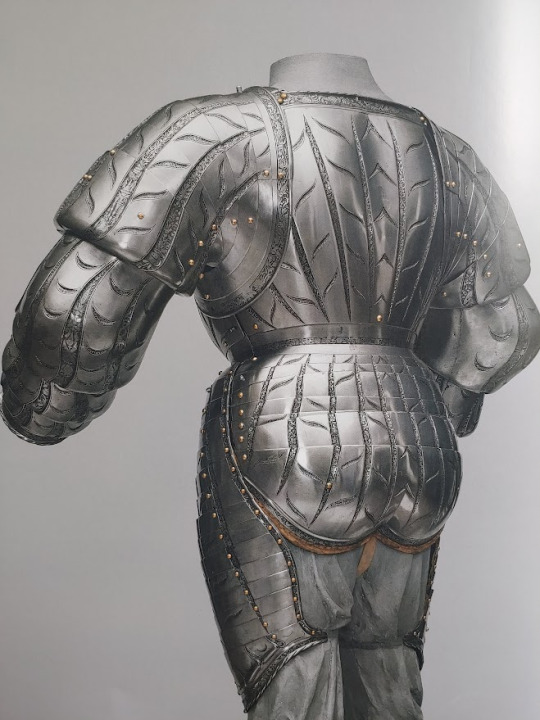
Both spaulders
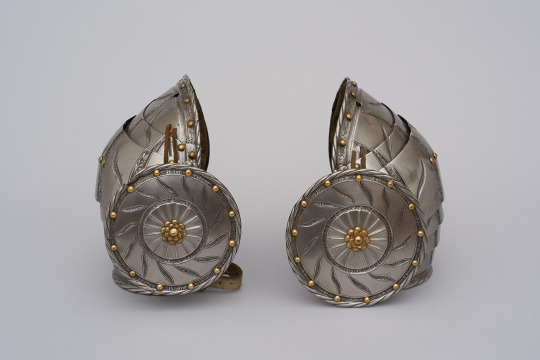
and gauntlets

survive. Additionally, the KHM retains the armor’s right vambrace
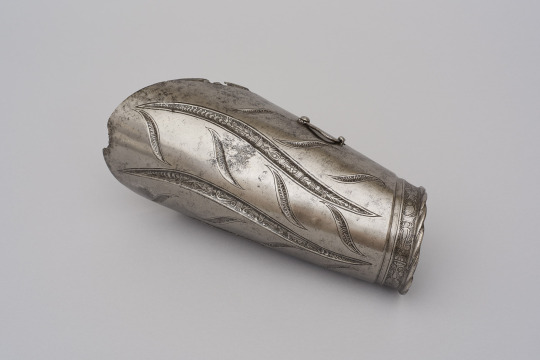
while the Wallace Collection holds the rerebrace and couter for the left arm.
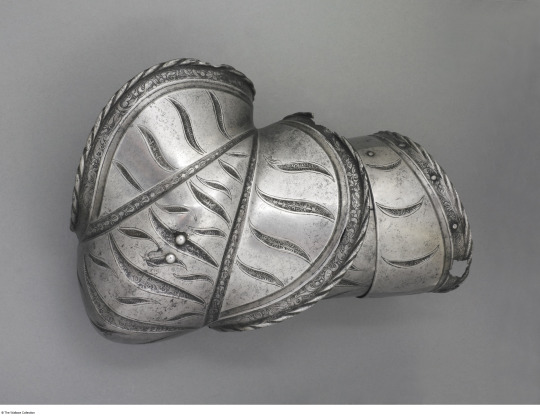
Recently, these pieces were assembled to show what the arm harness for field as a single unit would have looked like.
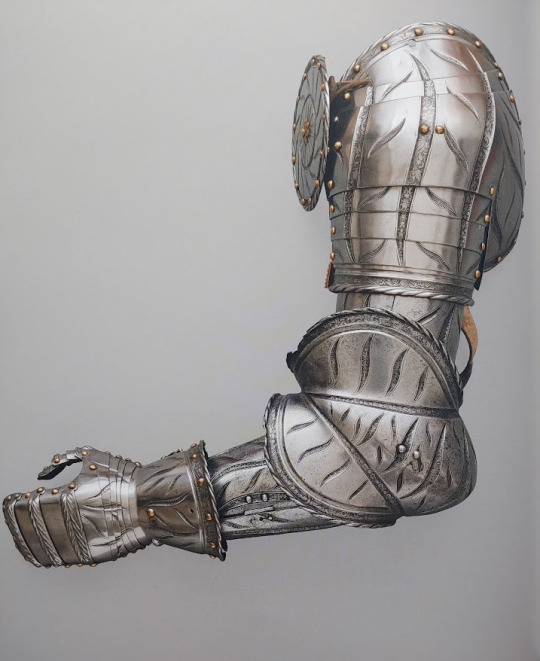
This armor would also have been accompanied by a gorget, now missing, and a helmet. Frequently, this armor is displayed alongside a close-helmet, however it is more likely the armor would have been accompanied by a burgonet similar in form to this example from the KHM.
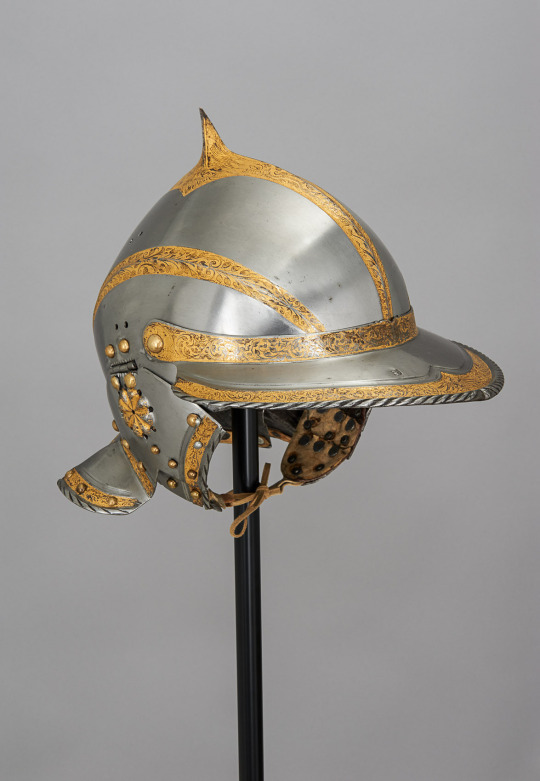
One final, unique surprise this armor holds is a hidden lance rest which is incorporated into the turned edge by the right arm. This rest folds down to allow a light lance to be braced atop it, and when folded up, is nearly invisible so as to not ruin the smooth surface of the breastplate with the prominent staples typically required for affixing a lance rest.

The third and final armor of this group is housed at the Metropolitan Museum of Art in New York City.

The least complete of these three armors, it may also be the most visually impressive. Comprised of only a backplate, hoguine, and arms, the puffs and slashes of this piece (also by Kolman Helmschmid and Daniel Hopfer) are ornately cusped. The slashed regions, displaying the gilded “fabric” beneath, and heavily etched to resemble an expensive silk brocade.
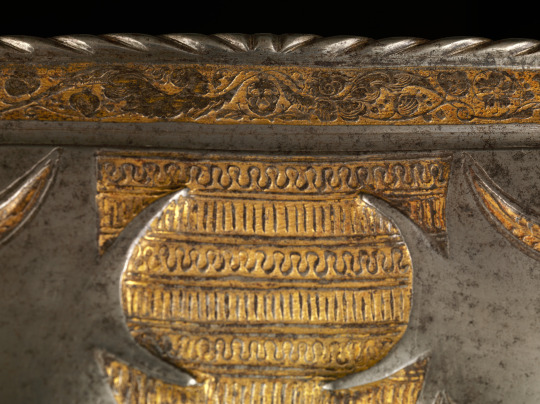
The sleeves of this armor are even more voluminous than those of the Rogendorf armor, though they are similarly articulated and provide the wearer with a surprising degree of mobility. It is thought that this armor may have been made for prominent Polish nobleman Jerzy Herkules Radziwill.
Interestingly, the hoguine of this armor is composed of two separate plates, rather than a single solid plate. Where the hoguine of the other two armors terminates in a decorative fabric border, the Met armor continues into two more articulated lames, covering the top rear of the thighs. Holes along the bottom edge suggest that this armor may have been accompanied by fully enclosing cuisses which pointed to the bottom of the fauld and hoguine.
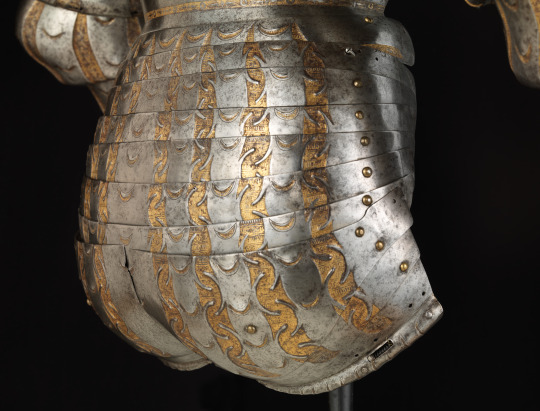
Sources
“A Pair of Gauntlets.” Kunsthistorisches Museum Wien. https://www.khm.at/de/object/540164/.
“A Pair of Spaulders with Besagews.” Kunsthistorisches Museum Wien. https://www.khm.at/de/object/372772/.
Cranach, Lucas the Elder. “Portrait of Duke Henry of Saxony.” Staatliche Kunstsammlungen Dresden. https://skd-online-collection.skd.museum/Details/Index/246875.
Krause, Stefan. Fashion in Steel. Vienna: Kunsthistorisches Museum, 2017.
“Landsknecht Costume Armour.” Kunsthistorisches Museum Wien. https://www.khm.at/de/object/372771/.
“Left Upper Cannon and Couter.” The Wallace Collection. https://wallacelive.wallacecollection.org:443/eMP/eMuseumPlus?service=ExternalInterface&module=collection&objectId=60736&viewType=detailView.
“Open Burgonet.” Kunsthistorisches Museum Wien. https://www.khm.at/en/object/503346/.
“Parts of an Armour.” The Wallace Collection. https://wallacelive.wallacecollection.org:443/eMP/eMuseumPlus?service=ExternalInterface&module=collection&objectId=60519&viewType=detailView.
“Portions of a Costume Armor.” The Metropolitan Museum of Art. https://www.metmuseum.org/art/collection/search/27790.
“Vambrace.” Kunsthistorisches Museum Wien. https://www.khm.at/de/object/372773/.
“Wilhelm von Rogendorf.” Kunsthistorisches Museum Wien. https://www.khm.at/de/object/1409642/
.
#long post#armor#armour#landsknecht#costume armor#art#history#renaissance#germany#german#hre#holy roman empire#europe#european#themet#metmuseum#khm#skd#wallace collection
1K notes
·
View notes
Text

Izzy Moonbow decides to do a painting of her own whilst visiting the Wallace collection.
In London, England.
33 notes
·
View notes
Text

Venus and Adonis, Pierre-Paul Prud'Hon, 1810-12
#venus#adonis#wallace collection#pierre paul prud'hon#19th century#art history#art#aesthethic#french art#painting#greek mythology
18 notes
·
View notes
Text

Day 2195, 26 June 2024
This is the entrance to the Wallace Collection, a museum and art gallery not far from Oxford Street in London. It houses apparently a collection of fine paintings, sculptures and ceramics. Typical of many residents of a city, I have miserably failed to visit this place of interest in my own city. Therefore I have now scheduled a visit for a grey and wet Sunday in November.
19 notes
·
View notes
Text

My grandfather used to have a copy of this painting. I would be sited in front of it every year for Christmas. We had to sell it. I come to see the original everytime I come to London. This time I decided to make a copy for myself.
#my art#wallace collection#pen drawing#not gonna lie it made me sad to see this painting#i miss my grandpa
7 notes
·
View notes
Text
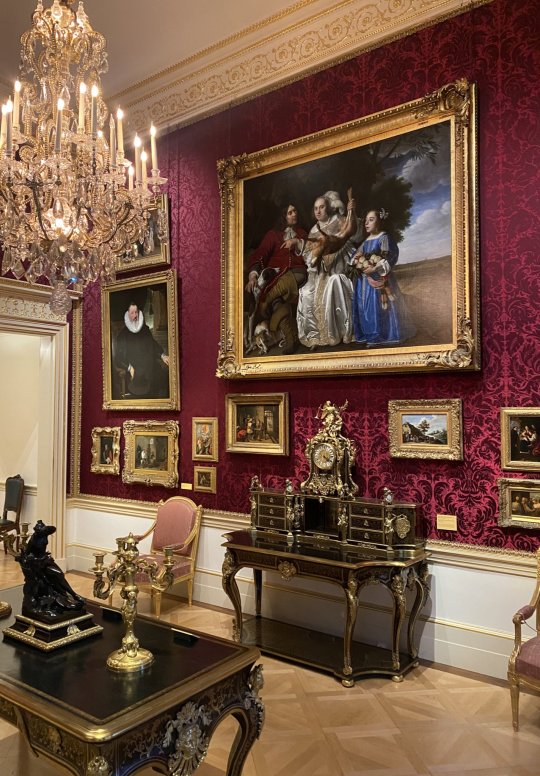
The Wallace Collection, London
#dark academia#light academia#classical#academia aesthetic#escapism#academia#books and libraries#classic literature#books#architecture#interior#design#old#antique#wallace collection#London#royal core#cottage core#furniture#aesthetics#mood#vibe#beautiful#tumblr
44 notes
·
View notes
Text










It would be striking and worth a visit all on its own- but I’ve mainly come to see The Swing, by Jean-Honoré Fragonard. We studied it in art history as a prime example of rococo and so it was really neat to be able to see it in person!
You do have to hunt for it a bit, but once you find the room it’s in it’s rightfully the centerpiece.
3 notes
·
View notes
Text
youtube
youtube
youtube
youtube
youtube
Went down a rabbit hole today
4 notes
·
View notes
Text
For #InternationalTigerDay + #MetalMonday:


Tiger-Headed Mace of Office
Deccan, India, late 18th century
Silver, gold, garnets, stone
L 77.3 cm, 2.7 kg
The Wallace Collection OA1760
“This beautifully-wrought silver-gilt tiger-headed mace, one of a pair, was intended not as a weapon but was employed purely for processional use, being carried by harbingers to herald the imminent approach of a prince, nobleman or important official. The tiger’s eyes are made of garnets and a green stone is mounted in the centre of the forehead. Although appearing to be of massive and deadly weight, such maces were usually hollow, made out of thin sheet-silver, embossed, chased, engraved and parcel-gilt. The hollow shell was filled with pitch, or a similar substance, to confer a degree of strength and rigidity. Similar examples bearing different animal’s heads (horses, bulls or elephants, for example) are also known.”
#animals in art#animal holiday#Indian art#South Asian art#Asian art#arms and armor#mace#tiger#metalwork#silver#gold#precious stones#Metal Monday#International Tiger Day#Wallace Collection#colonial art
95 notes
·
View notes
Photo
As an armorer I really appreciate these tips, they'll help when sketching designs prior to forging or to have a portfolio of the templates people can see. As a writer and artist, I REALLY appreciate the logical and realistic approach, I'm firmly on the side of realism and not fantasy armor.
Another good resource for some armor-in-motion would come from wiktenaur, they document traditional fight manuals for HEMA but those have a lot of sketches of the stances/moves described. And it's free!
If you want to spend money and can find it, the Wallace Collection put out a hardcover book with a thumb drive of 3D models of weapons and armor.
Techniques of Medieval Armor Reproduction by Brian Price is aimed at the armorer, but there are a lot of useful pictures and sketches that cover moving parts, proportions, designs, etc.
And of course, even though Facebook is a cesspit, there are a lot of really good armors who post photographs of their Works finished and in progress that can help give you an idea for designs as well.
Happy drawing!
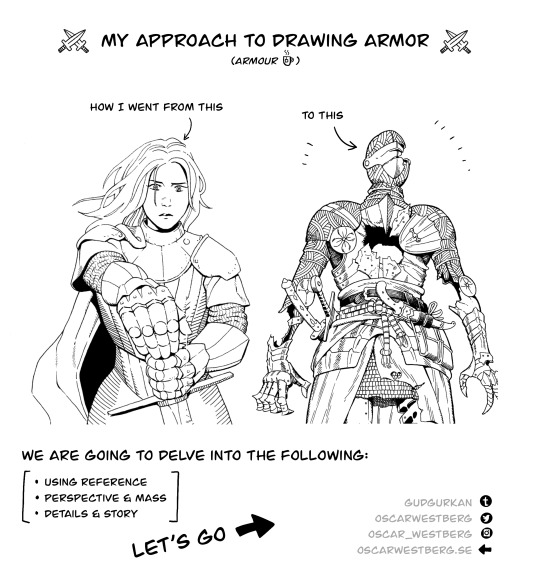

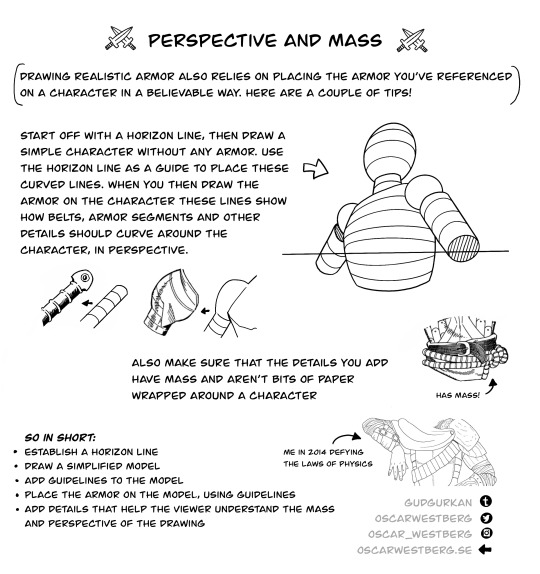
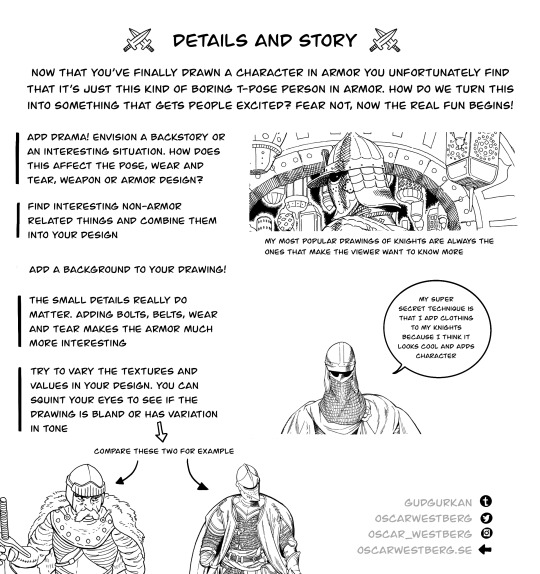
Here’s a ⭐️ tutorial ⭐️ on my approach to drawing armor!
#art advice#armor#armoring advice#I'm a better armorer than artist but I still hope some of my references help!#medieval arms and armor#wiktenauer#wallace collection#united league of armorers
12K notes
·
View notes
Text

Highlights went to see the portrait of The Laughing Cavalier by Frans Hals.
In the Wallace Collection, in London, England.
13 notes
·
View notes
Text
Nicolas Lancret (1690 - 1743)
Lancret (self-portrait) Imaginea este un portret al lui Nicolas Lancret, un pictor francez rococo. Pictura este realizată în ulei pe pânză și îl înfățișează pe Lancret într-o ipostază de trei sferturi, ținând o paletă și pensule. Poartă o jachetă visiniu și o cămașă albă cu guler de dantelă. Părul lui este coafat într-o perucă pudrată. Fundalul este de un maro închis, ceea ce ajută la…

View On WordPress
0 notes
Text
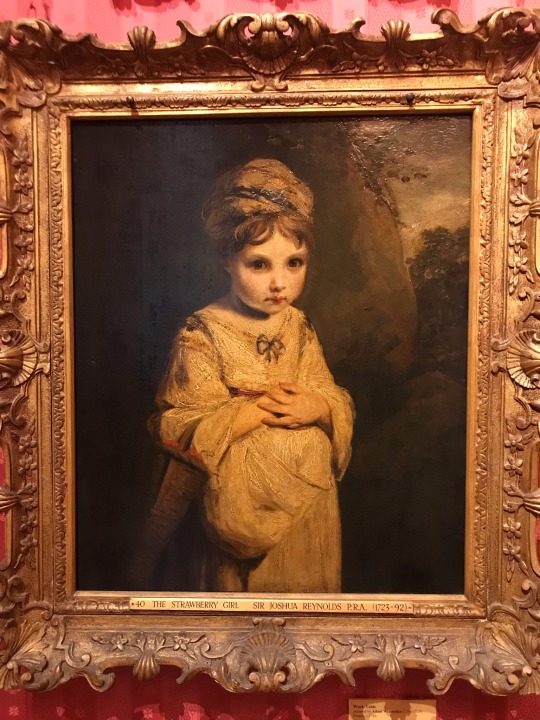
Wallace Collection, London
1 note
·
View note
